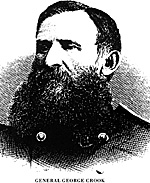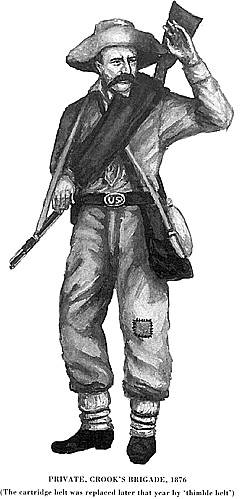 On May 29th, 1876, the "Big Horn and Yellowstone Expedition" commanded by the veteran Indian fighter, General George Crook (at right) , marched north out of Fort Fetterman, Wyoming, to fullfil their part in Brigadier-General Alfred H. Terry's strategy to trap the Sioux and Cheyenne in the Big Horn Mountains. Crook was to drive the enemy north towards Terry and Gibbon's converging columns, but if necessary his column was regarded as strong enough to deal with them on its own.
On May 29th, 1876, the "Big Horn and Yellowstone Expedition" commanded by the veteran Indian fighter, General George Crook (at right) , marched north out of Fort Fetterman, Wyoming, to fullfil their part in Brigadier-General Alfred H. Terry's strategy to trap the Sioux and Cheyenne in the Big Horn Mountains. Crook was to drive the enemy north towards Terry and Gibbon's converging columns, but if necessary his column was regarded as strong enough to deal with them on its own.
Order of Battle of the Big Horn and Yellowstone Expedition
Officer Commanding: Brigadier-General George Crook
Expedition Cavalry: Lieutenant-Colonel W.B. Royall (3rd Cavalry)
3rd U. S. Cavalry: Major Andrew W. Evans
1st Battalion Captain Anson Mills
- Company A (Lieutenant Charles Morton)
Company E (Captain Alexander Sutorious)
Company I (Captain William Andrews)
Company M (Captain Anson Mills)
2nd Battalion Captain Guy V. Henry
- Company B (Captain Charles Meinhold)
Company D (Captain Guy V. Henry)
Company F (Lieutenant Bainbridge Reynolds)
Company L ( Captain Peter Vroom)
Van Vleit's Squadron Captain Frederick Van Vleit
- Company C (Captain Van Vleit)
Company G (Lieutenant Emmet Crawford)
2nd U.S. Cavalry Battalion Captain Henry E. Noyes
- Company A (Captain Thomas B. Dewees)
Company B (Lieutenant William Rawolle)
Company D (Lieutenant Samuel M. Swigert)
Company E (Captain Elizah R. Wells)
Company L (Lieutenant Fred W. Kingsbury)
Total: c. 900 cavalry
Mounted Infantry Battalion Major Alex Chambers
- 4th U.S. Infantry Company D (Captain A.B. Cain)
4th U.S. Infantry Company F (Captain Gerhard Luhn)
9th U.S. Infantry Company C (Captain Sam Munson)
9th U.S. Infantry Company H (Captain A.S. Burt)
9th U.S. Infantry Company G (Captain T.B. Burrowes)
Total: c. 300 infantry
Packers, miners, and Indian auxiliaries.
Grand Total: c. 1,300.
Crook's column made slow progress in wintry conditions. From the beginning of its march, the column was under observation by the Sioux, and Crook was forced to detach his white scouts to hasten promised Indian auxiliaries. By June 7th he was pushing down Prairie Dog Creek towards the Tongue River, deeper into hostile territory. This was made evident on June 9th, when a party of Cheyenne under Little Hawk attempted to stampede some of the expedition's horses. They failed, but Crook was evidently sufficiently disturbed to fall back two days later to Goose Creek. It was never his practice to reveal his plans, if any; possibly, lacking hard information about the enemy he was simply uncertain what his next move should be.
On June 14th, the column was joined by 175 Crow and 86 Shoshone "friendlies", and on June 16th Crook resumed his march, this time at the head of a mobile force, stripped down to essentials. There were no waggons, but each man carried four days' rations, a blanket, and 100 rounds of ammunition. Additional supplies were carried on a small mule pack train. Total strength of the force was about 1,325 men.
Objective
Crook's objective was to seek out and destroy the hostiles' village, but its whereabouts were unknown. In fact the Indian force, now about 1,000 warriors in all, were camped on Rosebud Creek. There was no clear overall leader, though an influential role was played by Crazy Horse of the Oglala Sioux. Crazy Horse had distinguished himself during Red Cloud's War. He was never a chief, but had a reputation as a "war leader", with considerable qualities of bravery and powers of leadership. He was a solitary individual, with a reputation as a visionary he may in fact have been mentally unbalanced. Crazy Horse seems to have made some attempt to modify Indian methods of warfare to be able to meet the threat presented by the Americans, but his efforts had only limited impact.
Indian morale was high, partly as a result of a vision which had been vouchsafed to the leading shaman, Sitting Bull, which was interpreted as promising a victory over the white man, and more warriors flocked into the camp.
 PRIVATE, CROOK'S BRIGADE, 1876 (The cartridge belt was replaced later that year by 'thimble belt')
PRIVATE, CROOK'S BRIGADE, 1876 (The cartridge belt was replaced later that year by 'thimble belt')
Crook's column was led by his cavalry, followed by the mounted infantry, with the Indian auxiliaries on the flanks and scouting ahead. They crossed the Tongue River, and moved on north-west, but any lingering hopes which Crook may have had of taking the hostiles by surprise suffered a serious blow when his Indians came across a herd of buffalo, and charged down on them, screaming and firing their rifles. They were rounded up, reprimanded, and placed in the rear of the column, but the damage had been done.
In fact Crook's men had already been sighted by Cheyenne scouts, who carried word back to the encampment. However the Indians were divided on what course of action to adopt; most of the chiefs advised against taking the offensive, and Crazy Horse also seems to have spoken against hasty action. But the cautious element was shouted down by young warriors eager for action, and the outcome was a compromise, whereby it was agreed that volunteers should be allowed to go out and attack the enemy.
Indians
No Indian order of battle as such existed, but information on the tribes present in the camp gives some indication of those who took part in the fighting.
- Northern Cheyenne c. 150 warriors
Oglala Sioux c. 120
Blackfoot Sioux c. 20
Brule Sioux c. 100?
Sans Arc c. 75
Miniconjou c. 100
Hunkpapa c.300
Santee c. 50
Total: c. 900-1,000 warriors.
The first warriors, many resplendent in full ceremonial war dress, began to leave camp around midnight, though some, including the Hunkpapa, did not arrive until after fighting had actually begun.
Crook had camped for the night on the south fork of the Rosebud, in a valley surrounded by bluffs. His men passed an uneasy night. There was a general feeling that battle was imminent; one officer remarked: "We will have a fight tomorrow, mark my words - I feel it in the air." The hostiles in the meantime were moving closer; some Cheyenne under Two Moon and Spooted Wolf rode south-east across the Rosebud, whilst others headed up the south fork of what was later to be known as Reno Creek.
More Crook Versus Crazy Horse
Back to Colonial Conquest Issue 8 Table of Contents
Back to Colonial Conquest List of Issues
Back to MagWeb Master List of Magazines
© Copyright 1996 by Partizan Press.
This article appears in MagWeb (Magazine Web) on the Internet World Wide Web.
Other military history articles and gaming articles are available at http://www.magweb.com